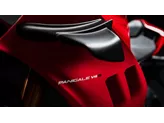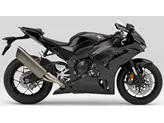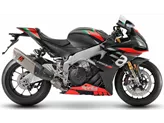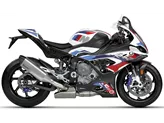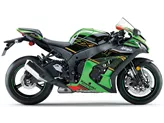BMW S 1000 RR 2016 vs. Suzuki GSX-R 1000 R 2017

BMW S 1000 RR 2016

Suzuki GSX-R 1000 R 2017
Pregled - BMW S 1000 RR 2016 vs Suzuki GSX-R 1000 R 2017
The BMW S 1000 RR 2016 and the Suzuki GSX-R 1000 R 2017 are both powerful supersport motorcycles that offer impressive performance on the road.
Starting with the engine specifications, both bikes have an inline 4-cylinder engine with a displacement of 999cc. However, there are some differences in the bore and stroke measurements. The BMW S 1000 RR has a bore of 80mm and a stroke of 49.7mm, while the Suzuki GSX-R 1000 R has a slightly smaller bore of 76mm and a longer stroke of 55.1mm. This results in the Suzuki having a higher compression ratio of 13.2 compared to the BMW's 13.
In terms of power, the Suzuki GSX-R 1000 R takes the lead with 202 horsepower, compared to the BMW S 1000 RR's 199 horsepower. The Suzuki also has a higher torque output of 118 Nm, while the BMW produces 113 Nm of torque. Both bikes have a 4-cylinder configuration and feature an inline engine type.

BMW S 1000 RR 2016
Moving on to the suspension, the BMW S 1000 RR 2016 is equipped with a telescopic fork front suspension and a swing arm rear suspension. On the other hand, the Suzuki GSX-R 1000 R 2017 features an upside-down telescopic fork front suspension and a swing arm rear suspension. Both bikes have an aluminum frame, with the BMW having a twin tube frame type and the Suzuki having a twin tube, twin-spar frame type.
When it comes to braking, both bikes have double disk brakes at the front. The BMW S 1000 RR uses radial technology for its front brakes, while the Suzuki GSX-R 1000 R uses radial, monoblock technology.
In terms of dimensions and weights, there are some slight differences between the two bikes. The BMW S 1000 RR has a wheelbase of 1425mm, while the Suzuki GSX-R 1000 R has a slightly shorter wheelbase of 1410mm. The seat height of the BMW is 815mm, while the Suzuki has a slightly higher seat height of 825mm. Both bikes have a fuel tank capacity of 17.5 liters. The BMW weighs 204kg with ABS, while the Suzuki weighs slightly less at 203kg with ABS.

Suzuki GSX-R 1000 R 2017
Now let's discuss the strengths and weaknesses of each bike. The BMW S 1000 RR 2016 has a very powerful engine, producing 199 horsepower, and offers a comfortable seating position. It also has an excellent shift assistant, making gear changes smooth and effortless. However, it is somewhat sluggish in curves, which may affect its performance on twisty roads.
On the other hand, the Suzuki GSX-R 1000 R 2017 has a high-revving engine with 202 horsepower, providing exhilarating acceleration. It also boasts a super stable performance on corner exit and radius, making it a great choice for riders who enjoy aggressive cornering. The Suzuki also features a great quickshifter, allowing for seamless gear changes. Additionally, it has a high-quality chassis, enhancing its overall performance and handling. However, the engine brake is not adjustable, which may limit customization options for some riders. The wheely control is linked to the traction control, which may not be ideal for riders who prefer separate control over these features.
In conclusion, both the BMW S 1000 RR 2016 and the Suzuki GSX-R 1000 R 2017 are impressive supersport motorcycles with their own strengths and weaknesses. The BMW offers a powerful engine and comfortable seating position, while the Suzuki excels in high-revving performance and stability on corners. Ultimately, the choice between these two bikes will depend on the rider's preferences and priorities.
Tehničke specifikacije BMW S 1000 RR 2016 u odnosu na Suzuki GSX-R 1000 R 2017
Prednosti i nedostaci u odnosu na
Prednosti i nedostaci u odnosu na
BMW S 1000 RR 2016

The S 1000 RR is the universal talent among the superbikes - you sit on it and feel comfortable straight away. Although it seems a bit nervous in comparison in terms of chassis and stability. However, it converts this into pleasantly easy handling and impresses with its enormous engine power. The front wheel is indeed particularly light and has to be calmed by the steering damper. An incredibly sporty and at the same time comfortable feature is the shift assistant for upshifting and downshifting - this brings calm to the chassis and you can fully concentrate on driving.
Suzuki GSX-R 1000 R 2017

Suzuki has done a great job with the GSX-R 1000 R 2017. A powerful motorbike with a fabulously smooth torque curve. Actually unbelievable at 202 hp! The chassis is of high quality and the electronics package has no tinsel but delivers top performance.
Usporedba cijena Prosječna tržišna cijena BMW S 1000 RR vs Suzuki GSX-R 1000 R
There are a few key differences between a BMW S 1000 RR 2016 and a Suzuki GSX-R 1000 R 2017. There are the same number of bikes of both models available on the 1000PS.de marketplace, specifically 7. It takes less time to sell a BMW S 1000 RR with 69 days compared to 176 days for a Suzuki GSX-R 1000 R. Since model year 2010 1000PS.de editors have written 135 reviews for the BMW S 1000 RR and 13 reviews for the Suzuki GSX-R 1000 R since model year 2017. The first review for the BMW S 1000 RR was published on 4/16/2008 and now has more than 4,000 views. This compares to more than 197,700 views for the first review on Suzuki GSX-R 1000 R published on 10/4/2016.


